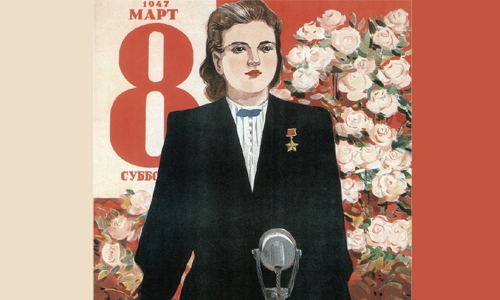Have you wished your mother a happy international women’s day yet?
About a decade ago, I stopped sending flowers on Mother’s Day for political reasons. My mom, a high-school-educated Nuyorican with a soft spot for Hallmark holidays, was not pleased. “But I don’t want to celebrate you only as a mother,” I tried to explain. A resilient woman who once worked two jobs after my father abandoned her with three mortgages, two kids and no child support, she was more than just a parent to me. She was a superhero.
“ I want to acknowledge everything that you are,” I told her. “The whole person.” I started sending my mom flowers on March 8 instead. It didn’t go over well the first year. The date meant nothing to her. “It’s International Women’s Day, and it’s celebrated all over the world,” I persisted. “The United Nations declared it an official holiday in 1975.” “I’ve never seen a card for that,” she said. “Well, it’s not celebrated in the United States.” At this, my mom harrumphed. “Why not?” That’s complicated, I told her.
Although a National Women’s Day was first proposed by the Socialist Party of America and observed in New York in 1909, it was Clara Zetkin, a German Marxist feminist, who formally instituted an international day to celebrate working women at the Second International Congress of Socialist Women in Copenhagen in 1910. Millions began marking International Women’s Day annually after March 8, 1911. On International Women’s Day in 1917, Russian women demonstrated for bread and an end to World War I, and sparked a revolution that forced the Czar’s abdication.
After the Bolshevik Revolution, Vladimir Lenin and his newly appointed commissar of social welfare, Alexandra Kollontai, declared International Women’s Day an official holiday in the Soviet Union. From Europe, I explained to my mom, the celebration of March 8 spread across the globe. The early socialists yearned for a world where men and women were equal. They understood the inherent misogyny and sexism that underlay patriarchal cultures. By establishing a special day to recognise women, they called attention to the obstacles women face the other 364 days of the year.
Socialists embraced the radical idea that a woman is more than a mother, though she may be that, too. They fought to create a world that also valued women as workers, as citizens and as fully equal members of society. They desired an economic system in which a woman need not be dependent on a man, where she would not have to be a superhero to successfully raise two kids after their father abandons them. Of course, 20th-century socialist states did not create the world they wanted, but it was not for lack of trying. Different countries implemented different policies, but none achieved the full equality they had promised.
Over a century after socialists expressed their goals, women still earn only 63 per cent of what men are paid, 35pc of women will still be the subject of physical violence by men, and divorce often still means financial ruin. More than 25 countries mark International Women’s Day as an official holiday, and it is observed unofficially in at least a dozen more. In some countries, women receive flowers and gifts, while in others it is a day of parades and protests for women’s rights. But Americans have ignored it, largely because of its socialist origins and its historical association with the Eastern Bloc.
After the Cold War ended, Representative Maxine Waters of California and 79 co-sponsors tried to introduce legislation to designate March 8, 1994, as International Women’s Day in the United States. The bill never made it out of committee. Instead, Americans celebrate Mother’s Day, a holiday whose precursors united mothers around charitable works and pacifism. Following the Civil War, Anna Reeves Jarvis organised “Mothers’ Friendship Days” to promote reconciliation. In 1907, her daughter, Anna Jarvis, began lobbying to make Mother’s Day a national holiday, flooding Washington with letters until Woodrow Wilson formally established it in 1914.
In Jarvis’ vision, it was a day to quietly acknowledge the sacrifices mothers made for their children. But merchants soon co-opted Mother’s Day, using the occasion to sell more chocolates, flowers, gifts and yes, greeting cards. Jarvis spent the rest of her life fighting the commercialisation of Mother’s Day. She hated the holiday so much that she actually tried to have it removed from the American calendar. For my part, I despise that Mother’s Day values women only as mothers. It reinforces the idea that this is our most important role: giving birth and sacrificing enormous amounts of unpaid labour towards raising the next generation of citizens. We are more than our wombs.
Despite my rationalisations, my mother remains skeptical. She is a lifelong Democrat and we tend to agree on most things, but I know my leftist feminist politics are a bit too radical for her. I’m sure she would prefer to get her blossoms on Mother’s Day like all of the other women with “normal” daughters. Still, I have stuck to my guns. Each year I send a bouquet in March instead of May, trying to win her over. I forward her articles about International Women’s Day celebrations from Afghanistan to Zambia, and share photos of rallies in Brazil and Nepal.
Since November 2016, I’ve been helped by increasing media attention to March 8, the growing radicalisation of American women and a rising interest in democratic socialism. I imagine a fellow Puertorriqueña, Alexandria Ocasio-Cortez, may celebrate International Women’s Day as well. Today, my mom tolerates my hatred of Mother’s Day. And not only because she gave birth to me. Also because she is a capable, open-minded and loving human being who has faced and overcome many obstacles in life, the least of which are her daughter’s militant idiosyncrasies.
Related Posts

